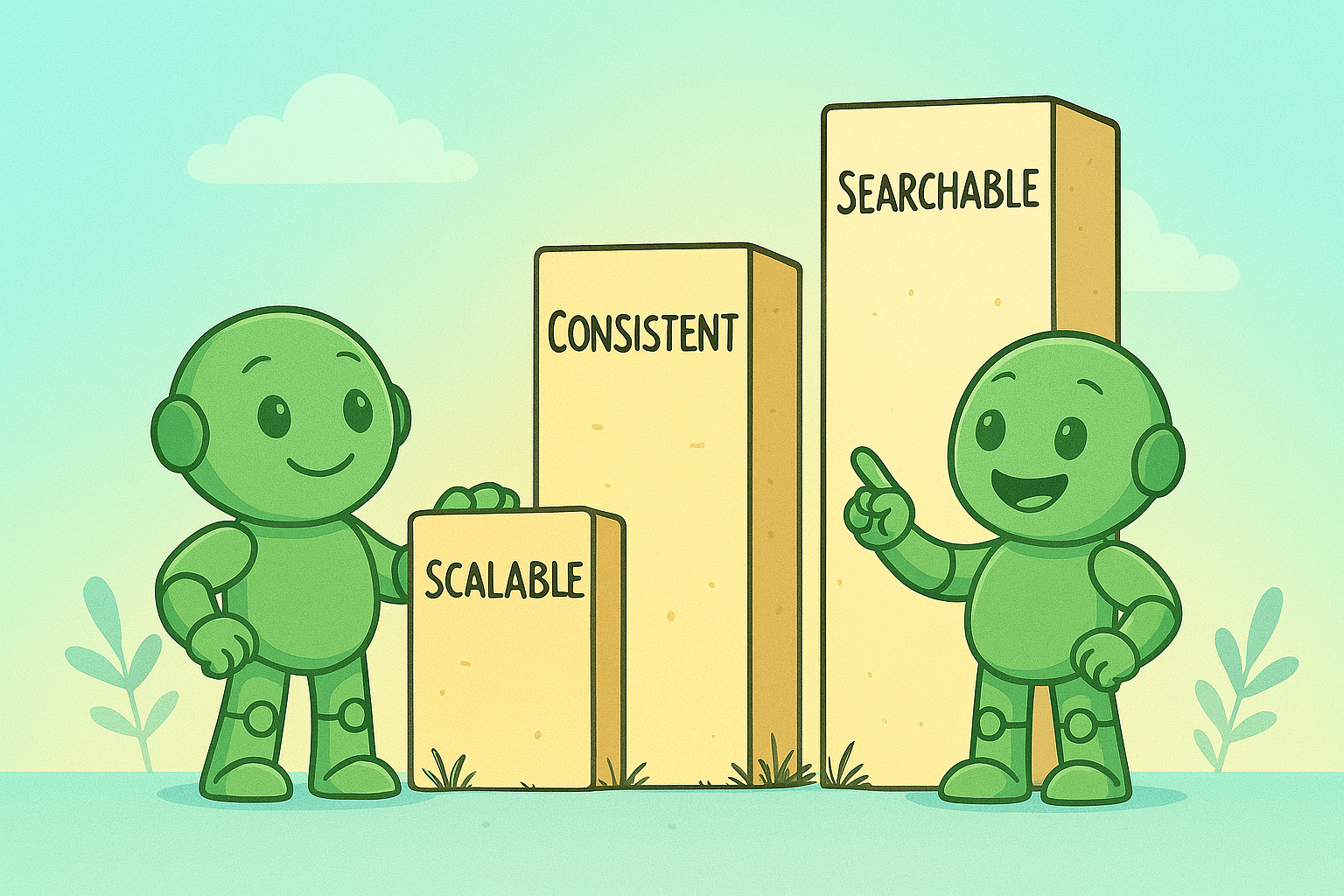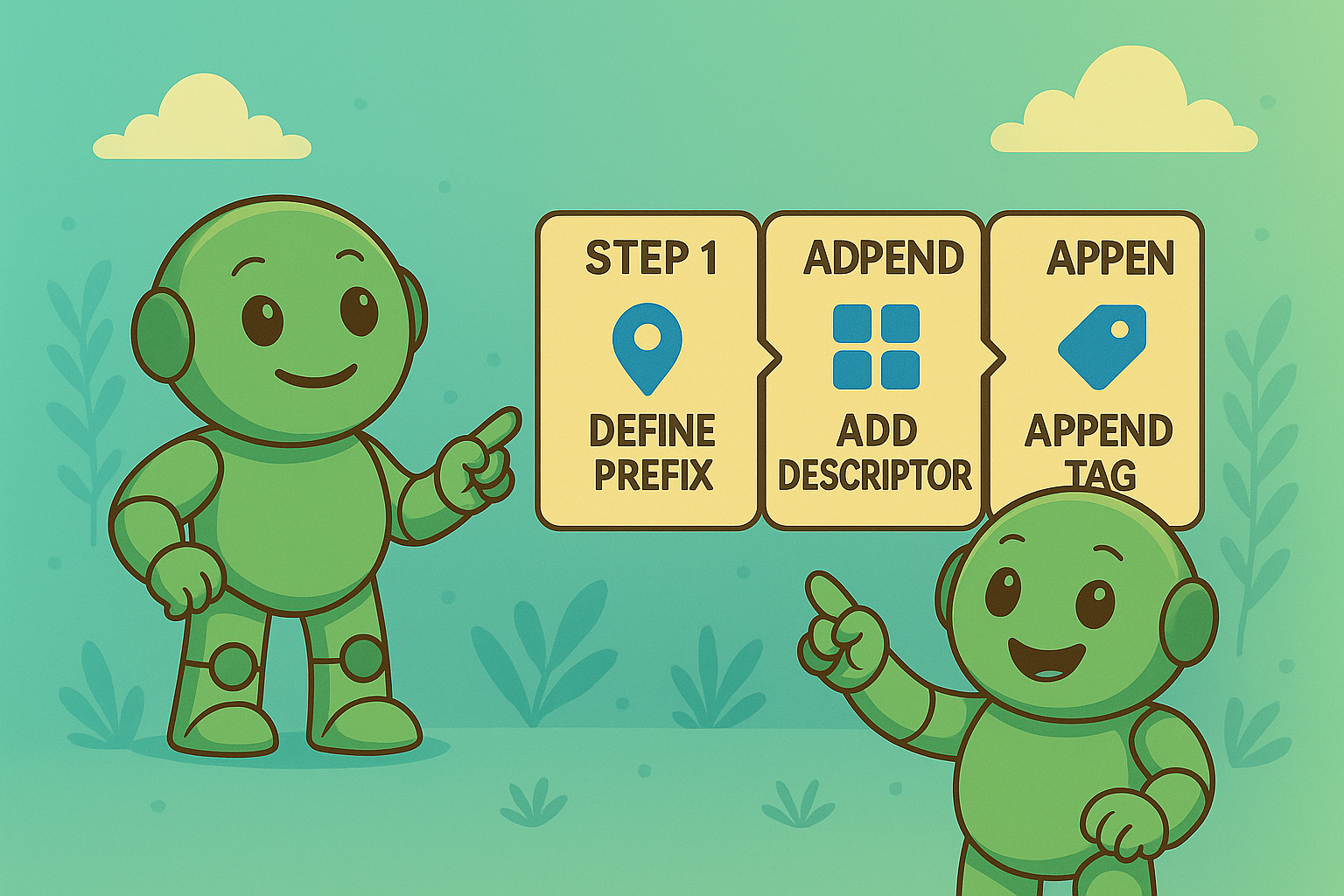Project Naming Conventions: Build Systems That Scale
When Bad Names Destroy Good Projects

Imagine wading through a folder overflowing with files like "Project_Final_v2," "Project_Final_Final," and the inevitable "Project_Final_ACTUAL_Final." We've all been there, right? This seemingly small annoyance is more than just frustrating; it can actually sabotage a project's success.
Talking with project managers reveals a recurring theme: poor naming conventions have a domino effect, creating problems that can throw entire teams off track.
One major issue is the sheer amount of time wasted searching for files. That innocent "temp" folder from months ago might seem harmless, but multiply that across countless projects and team members, and the lost time adds up. It's not just about the minutes ticking by; it's the mental drain and frustration of constantly hunting for the right information. This inevitably saps productivity and impacts deadlines.
Unclear naming conventions also increase the risk of errors. When team members accidentally work on the wrong file versions due to confusing names, mistakes proliferate. This affects the quality of the final deliverable and leads to rework, causing further delays and increased costs.
Imagine, for example, a marketing team unknowingly using an outdated logo or a development team working on the wrong branch of code. These errors can be expensive and time-consuming to fix.
Beyond the practical implications, confusing naming systems can erode team confidence. The constant struggle to find the right files creates a sense of chaos and undermines the team's belief in their ability to execute the project effectively. This impacts morale and can lead to a decline in the overall quality of the work.
The financial repercussions of inconsistent naming can be significant. Inefficient practices contribute to higher operational costs due to disorganization, increased errors, and those extended search times. History is full of examples where poor naming practices have led to costly blunders. The Y2K bug, for instance, cost the United States $150 billion to remedy. Learn more about the cost of poor file naming conventions here.
Effective project naming conventions aren't about obsessive tidiness; they're about laying a strong foundation for project success. They provide the clarity and structure needed for teams to operate efficiently, minimize mistakes, and maintain the confidence to deliver high-quality results.
Decoding What Makes Names Actually Work

Effective project naming conventions are like a well-organized filing system. They make it easy to find what you're looking for and keep everything neat and tidy. But what's the secret sauce to a naming system that truly works? It's all about finding the sweet spot between human readability and something a computer can easily process. This balance of clarity and functionality is essential for project naming success.
Balancing Brevity and Clarity
Think of a project name as a concise label. It needs to capture the project's essence without being a long, rambling sentence. Successful organizations achieve this by identifying the key components of their projects and weaving them strategically into the name. It's not about squeezing every single detail into the title, but rather choosing the most important pieces of information.
For example, instead of the unwieldy "WebsiteRedesignProject_MarketingDepartment_2024," a more effective name would be "Website_Marketing_2024." This shorter version is much easier to digest and still conveys the crucial information.
The Strategic Use of Elements
Dates, versions, and categories can be extremely helpful in project names, but they need to be used carefully. Too many of these elements can create long, complicated names that are difficult to remember and use. Effective naming conventions use these components strategically, combining them in a way that adds clarity without creating clutter.
Imagine you're working on a software project. Instead of “Alpha_v1.0_BugFix_2024-10-27,” a cleaner option would be “Alpha_v1.0_20241027.” This streamlined version merges the version and date while keeping the essential information intact.
Handling the Edge Cases
Let's face it, not every project fits neatly into a pre-defined box. These unusual projects, the "edge cases," are the ultimate test of a naming system's flexibility. Smart teams anticipate these scenarios and build adaptability into their conventions from the get-go. This might mean creating a special category for unique projects or implementing a tagging system with custom descriptions. For some more inspiration, check out this guide on finding project and software version names: How to Find Project Names and Names for Software Versions.
This proactive approach ensures the system doesn't break down when faced with something unexpected. It means even the most unusual projects can be easily identified and managed. These principles allow you to build names that not only meet your current needs but also adapt to future project changes.
Let's take a look at a table summarizing the key elements of effective project naming systems. This table breaks down the purpose of each element, where they are most effective, and provides a clear example format.
Essential Elements Of Project Naming Systems Comparison of key naming components and their effectiveness across different project types
| Naming Element | Purpose | Best Use Cases | Example Format |
|---|---|---|---|
| Project Name | Clearly identifies the project | All project types | Website Redesign |
| Department/Team | Specifies the responsible team | Larger organizations with multiple teams | Marketing |
| Year | Indicates the project's start year | Long-term or multi-year projects | 2024 |
| Version Number | Tracks different iterations | Software development, design projects | v1.0 |
| Date | Pinpoints specific releases or milestones | Projects with frequent updates | 20241027 |
As you can see, each element plays a specific role in making a project name informative and easy to understand. Using these elements strategically will significantly improve your project organization and communication.
Your Step-by-Step Framework Development Guide

The infographic above illustrates a simple three-step process for creating effective project naming conventions. Think of it like building with LEGOs: you start with a base plate (the prefix, like a project code), then add bricks that describe the specific part you're building (the descriptor, for the module or component). Finally, you add a label to show what version it is (the tag, for version or environment). This visual breaks down a potentially complex system into digestible chunks. The main takeaway? A structured approach, from general to specific, brings clarity and consistency to your project names.
So, are you ready to build a project naming system that actually makes your life easier? Let's explore a proven method used by successful teams to tailor conventions to their specific needs. We'll start by examining your current project landscape and identifying those naming headaches that drain your time and energy.
Engaging Stakeholders and Gathering Requirements
Bringing stakeholders into the conversation is crucial. Think of it like urban planning: you wouldn't build a city without consulting the residents, right? Through collaborative workshops, you can learn to steer these discussions, preventing them from devolving into subjective debates. For inspiration and tools, you might find this resource on naming tools helpful. Effective teams gather requirements from various departments, balancing differing needs to create a framework that serves everyone. This fosters buy-in and makes it much more likely that the new system will actually be used.
Implementing and Adapting Your Framework
We'll look at real-world examples of organizations that successfully implemented new naming standards. These stories highlight the importance of addressing resistance to change and providing proper training. Imagine trying to change the direction of a large ship – it takes time and careful maneuvering. A phased rollout of new conventions can minimize disruption, allowing teams to adjust gradually.
You'll also learn the crucial skill of knowing when to be flexible. Strict adherence to rules can sometimes hinder progress. We'll explore when to stick to the established conventions and when a bit of flexibility can actually boost your workflow. Knowing which battles are worth fighting is key. This balance ensures the system remains practical and useful in the long run.
This section includes templates for stakeholder interviews, worksheets for mapping your project naming convention requirements, and decision trees to help navigate competing options. These resources equip you to create living documentation that integrates into your workflow, rather than becoming a forgotten file. By the end of this guide, you'll have a clear methodology for building a naming system that scales and adapts as your projects grow and change.
Proven Patterns From Organizations That Scale
Building a successful project naming convention isn’t about picking a format and calling it a day. It’s about crafting a system that can adapt and grow right alongside your organization. Think of it like building a house – you wouldn't start without a blueprint that can accommodate future expansions, would you? Similarly, a robust naming convention acts as a blueprint for your projects, ensuring clarity and organization as your team and project portfolio expands.
Agile Approaches for Startups
Startups, often operating in fast-paced environments, need naming conventions that are as nimble as they are. Imagine a small team rapidly iterating on a new product. They need a system that lets them quickly identify and adapt to changing priorities, like a well-organized toolbox where everyone knows exactly where each tool is. Some tech startups use a simple structure like [Project Code]-[Sprint Number]-[Feature]. This provides immediate context – crucial in those fast-paced sprints. New team members can quickly grasp the project’s stage and focus, fostering efficient collaboration.
Stability for Enterprise Projects
Larger organizations, especially those with long-term projects, require a different approach. Consider a large-scale engineering project spanning several years. Consistency across all teams becomes paramount – like a universal language that everyone understands, regardless of their specific role. A more detailed convention might be needed, incorporating elements like [Department]-[Project Code]-[Year]-[Phase]. While more elaborate, this structure ensures everyone, from engineers to project managers, is on the same page. This is where consistent naming conventions truly shine, minimizing errors and boosting collaboration, which is essential for scaling complex projects.
Tailoring Conventions for Different Project Types
Just as different tools are needed for different tasks, project naming conventions should also consider the nature of the work. A marketing campaign might use a naming convention focused on the target audience or platform, such as [Campaign Name]-[Platform]-[Year]. This immediately clarifies the campaign's purpose and reach. On the other hand, a research project might prioritize the research area or methodology, using a pattern like [Research Area]-[Methodology]-[Year]. This ensures the name reflects the project’s core elements. By tailoring the naming convention to the project's specific needs, you’re effectively creating a bespoke suit that fits perfectly, enhancing clarity and making it easier to track progress and find the information you need.
The Decision-Making Process
Talking to experienced project managers reveals valuable insights into creating scalable naming conventions. They emphasize the importance of involving stakeholders from different departments in the decision-making process. This collaborative approach avoids creating a system that only works for one team, much like designing a shared workspace that caters to everyone’s needs. These managers also stress the need for ongoing review and adjustment. A naming convention isn't set in stone; it’s a living document that needs to evolve as the organization grows and its projects become more complex. This flexibility ensures the system remains effective and adapts to the ever-changing needs of a growing company.
Learning From Global Leaders and Industry Standards

Let's explore how some leading organizations around the world have tackled project naming conventions. Think of it as a backstage pass to see how the pros do it, from the meticulous systems at the World Bank to the flexible approaches of major tech companies. These real-world examples offer valuable lessons for any organization, big or small.
Consistency Across Cultures and Time Zones
Imagine trying to coordinate projects across multiple countries, each with its own language and cultural context. It's like trying to conduct an orchestra where everyone speaks a different language. This is the challenge multinational organizations face daily. Consistency is key – a shared project language that everyone understands.
Leading organizations create clear, universal guidelines. These guidelines act as a universal translator, ensuring everyone is on the same page, whether they're in London, Tokyo, or New York. Organizations like the World Bank and Disney emphasize this, using clear file naming for seamless collaboration throughout a project’s life.
Adapting to Industry-Specific Needs
While core principles are important, every industry has its own quirks. Think of it like building a house – the foundation is always important, but the specifics of the design depend on whether you’re in a desert or a rainforest.
Highly regulated industries, like finance or healthcare, might need to incorporate compliance codes into their project names. Software development teams might use names that reflect agile methodologies. Understanding these industry-specific needs is crucial for tailoring your approach.
Handling Legacy Systems and Training New Team Members
Introducing new naming conventions in an organization with existing systems can be tricky. It's like renovating a historic building – you want to modernize without compromising its historical integrity.
Leading organizations use phased approaches to minimize disruption, gradually integrating new conventions with legacy systems. This gives teams time to adjust and prevents valuable data from getting lost.
Training is just as important. Clear documentation and practical examples help new team members quickly learn the ropes and contribute to a culture of consistent naming right from the start.
Evolving Standards for Growing Organizations
Project naming conventions aren't set in stone; they need to adapt as your organization grows. It’s like tending a garden – you need to prune and adjust to keep it healthy.
Successful organizations build flexibility into their systems, accommodating new project types, team structures, and even unexpected changes. Some even create internal communities where team members can share best practices and refine the naming system over time. This proactive approach ensures that naming conventions remain a valuable asset as the organization grows.
Avoiding The Traps That Sink Good Systems
Even with the best of intentions, project naming conventions can sometimes become a tangled mess. This section explores some common pitfalls that can trip up even the most organized teams, and offers practical strategies for navigating these challenges. You might be interested in: Does Every Company Need a Naming Strategy?
Complexity Can Kill
Overly complex naming systems, while often attractive on paper, can quickly become a burden in practice. Imagine trying to assemble a ridiculously complicated piece of furniture with a 100-page instruction manual. It's likely to lead to frustration and ultimately, you might give up altogether. Similarly, a naming convention with too many rules and exceptions can be difficult to remember and apply consistently, leading to inconsistencies and eventual abandonment. A simpler approach, even with some compromises, often proves more sustainable in the long run.
A good naming system should be easy to understand and use, like a well-designed tool. If it's too complex, it becomes more of a hindrance than a help.
Perfectionism Paralyzes
The quest for the perfect naming convention can be a trap in itself. Sometimes, in our desire to create the ideal system, we can get stuck in analysis paralysis. This can delay the implementation of any system, leaving projects in naming limbo. This is especially true when trying to reach consensus across multiple teams or stakeholders. Remember, a good system implemented today is far more valuable than a perfect system that never gets used.
Think of it like planning a road trip. You could spend weeks researching every possible route and attraction, but you might never actually leave. Sometimes, it's better to choose a good route and start driving.
Ignoring Team Input Leads to Failure
Naming conventions shouldn't be imposed from above. When teams aren't consulted, the resulting system often fails to meet their practical needs. It's like designing a kitchen without talking to the chef. It might look beautiful, but it could be completely impractical for actual cooking. Involving the team from the beginning ensures the system is tailored to their workflow and fosters a sense of ownership, leading to better adoption and adherence.
Teams are the ones who will use the naming convention day in and day out. Their input is essential for creating a system that actually works in practice.
Recognizing Warning Signs
It's important to be vigilant and spot the signs that your naming system might be going off track. Has consistency become rigidity, hindering the team’s ability to adapt to new situations? Has simplicity turned into ambiguity, causing confusion about the meaning of names? Is the system serving the rules, or is it serving the team? Recognizing these warning signs early allows for timely adjustments and prevents the system from becoming a source of frustration.
Technical Pitfalls
Even the best-designed naming conventions can be undermined by technical limitations. Think character limits within certain software, compatibility issues across different systems, or conflicts in version control. These technical hurdles can create unexpected headaches. Anticipating these challenges and building in safeguards, like predefined abbreviations or standardized character limits, can save a lot of time and frustration down the line. Sometimes, the best lessons are learned by addressing and fixing mistakes.
Let's look at some common naming convention mistakes and how to fix them:
Introducing the table below, which outlines some frequent pitfalls in project naming and offers proven strategies to avoid them. This will help you create a naming convention that’s both practical and effective.
Common Naming Convention Mistakes And Solutions
| Common Mistake | Why It Happens | Impact On Team | Prevention Strategy |
|---|---|---|---|
| Overly Complex Rules | Attempting to cover every possible scenario | Difficult to remember and apply consistently | Start simple and add complexity only as needed |
| Inconsistent Application | Lack of clear guidelines or enforcement | Confusion, errors, and wasted time | Provide clear documentation and training |
| Ignoring Team Input | Lack of communication and collaboration | System doesn't meet team needs, low adoption rate | Involve team members in the design process |
| Not Accounting for Tech Limits | Lack of awareness of software limitations | Frustration, errors, and rework | Research technical limitations and plan accordingly |
| Lack of Documentation | Assuming everyone understands the system | Confusion and inconsistencies | Create clear and accessible documentation |
The table above summarizes some of the key challenges in creating and implementing naming conventions. By understanding these common mistakes, you can proactively address them and create a system that works for your team. A well-designed naming convention can improve communication, reduce errors, and ultimately contribute to project success.
Your Implementation Roadmap That Actually Works
Knowledge is only potential power. To truly harness its strength, you need to put it into action. This section offers a practical roadmap for implementing effective project naming conventions, starting today. We'll cover everything from assessing your current situation to getting your team on board and navigating any hurdles along the way.
Auditing Your Current Naming Practices
Before constructing a new system, it's essential to understand your existing foundation. Think of it like renovating a house – you wouldn't start demolition without knowing the layout! Begin with a naming audit: a thorough review of your current project names. Note any inconsistencies, redundancies, or points of confusion. This creates a valuable baseline and pinpoints areas ripe for improvement. This isn't about assigning blame; it's about finding opportunities to enhance clarity and efficiency.
Creating Your Naming Guidelines
With a clear picture of your current naming landscape, you can start building your tailored guidelines. Imagine crafting a precise formula – the right ingredients combined in a specific order to achieve the desired outcome. Using the insights from earlier sections, determine the crucial elements for your project names (e.g., project code, department, date). Establish a clear format, such as [Project Code]-[Department]-[Date], and document it meticulously. This documented format becomes your project naming "recipe." Consider both human readability and compatibility with your existing software.
Getting Team Buy-In
Introducing any new process can sometimes be met with resistance. It's like introducing a new house rule – everyone needs to understand and agree. Present your proposed naming conventions to your team, clearly explaining the benefits. Highlight how consistent naming saves time, minimizes errors, and simplifies their daily work. Be receptive to feedback and willing to adapt. The goal is to create a system that everyone supports and uses actively.
Phased Implementation and Legacy Projects
Implementing your new naming conventions should be a smooth, gradual process. Avoid a sudden, disruptive overhaul; that's like trying to rearrange furniture while a party is in full swing! Phase in your new system, beginning with new projects. For older, legacy projects, assess the practicality of renaming everything. A hybrid approach, applying new conventions to new files within existing projects, might be more manageable.
Measuring Success and Maintaining Momentum
Once your system is live, monitor its effectiveness. Are people using it consistently? Have errors decreased? Is searching for files easier? Track relevant metrics to showcase the value of your new conventions. This helps maintain momentum and justifies ongoing refinement. Regularly review your system with your team and adjust as needed. A good naming system is like a well-tended garden – it needs consistent care to flourish.
Ready to improve your project organization and streamline your workflows? Visit NameRobot today and explore our powerful tools for crafting effective naming conventions.















